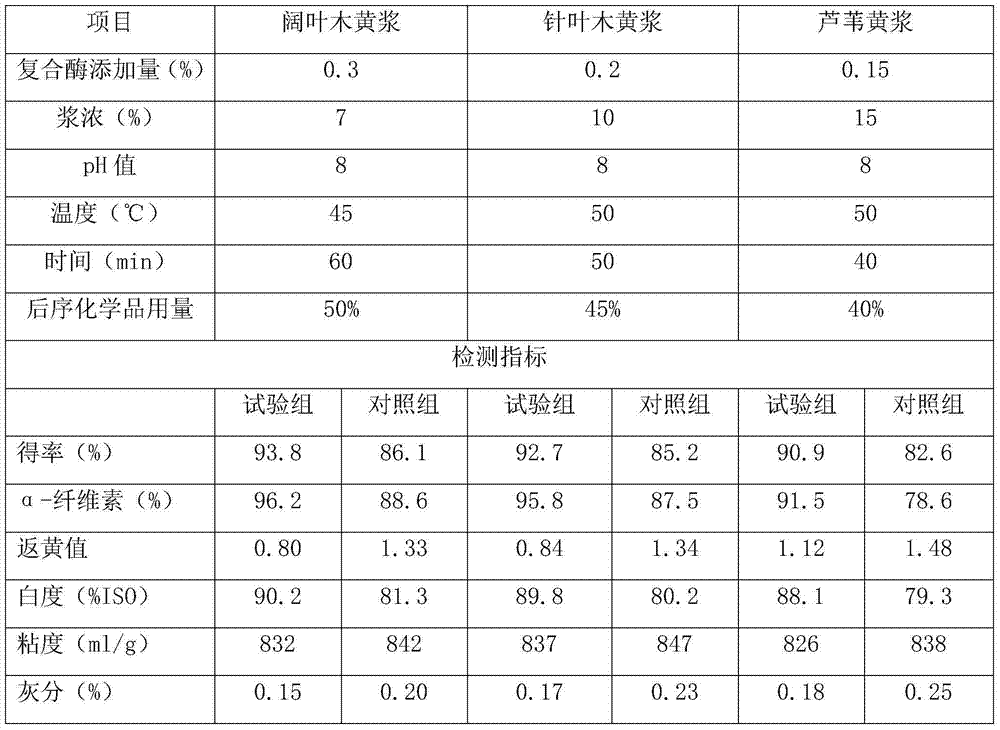Bleached compound enzyme and preparation method thereof
A compound enzyme and laccase technology, which is applied in the field of bleaching compound enzyme and its preparation, can solve the problems of low laccase yield, single enzyme type and characteristics, poor storage stability, etc.
- Summary
- Abstract
- Description
- Claims
- Application Information
AI Technical Summary
Problems solved by technology
Method used
Image
Examples
Embodiment 1
[0074] Embodiment 1 raw material preparation
[0075] 1. The preparation of alkaline xylanase: comprise the following steps
[0076] (1) Activation of bacteria
[0077] Inoculate the slant strain of the well-preserved thermophilic Bacillus CCTCC M 2013537 on the slant medium, culture at 45°C for 36 hours to activate the strain, and activate it 3 times;
[0078] The slant medium consists of: beef extract 10g, sodium chloride 12g, peptone 20g, glucose 5g, agar 20g, Chinese herbal medicine powder 10g, distilled water 1000mL, pH value 10, sterilized at 121°C for 20 minutes;
[0079] The preparation method of described Chinese herbal medicine powder is as follows:
[0080] In terms of parts by weight, weigh 25 parts of Astragalus membranaceus, 15 parts of Codonopsis pilosula, 12 parts of Bupleurum baicalensis, 12 parts of scutellaria baicalensis, 10 parts of Houttuynia cordata, and 9 parts of angelica sinensis; respectively crush the above-mentioned Chinese herbal medicines until...
Embodiment 2
[0105] Embodiment 2 Determination of high temperature resistant alkaline xylanase enzyme activity (3,5-dinitrosalicylic acid colorimetric method, referred to as DNS method)
[0106] 1. Reagents and solutions
[0107]1.1 Except for special requirements, the water used is third-grade water in accordance with the provisions of GB / 6682-1992, and the chemicals are all analytically pure unless otherwise specified.
[0108] 1.2DNS Reagent
[0109] Weigh 10g of 3,5-dinitrosalicylic acid and add it into 500ml of water, add 16g of sodium hydroxide in several times, stir to dissolve (temperature <45°C), then add 300g of potassium sodium tartrate in several times, stir until completely dissolved, After cooling, dilute to 1000ml with water. Store the brown bottle in a dark place at room temperature and use it after one week (if there is precipitation, use it after filtration).
[0110] 1.30.1mol / L, pH5.0 acetic acid-sodium acetate buffer
[0111] Take 1.8ml of glacial acetic acid, add ...
Embodiment 3
[0139] The thermostability analysis of embodiment 3 alkaline xylanase
[0140] The thermal stability of the enzyme was analyzed, and the crude enzyme liquid prepared by the alkaline xylanase in Example 1 was placed at 40°C, 45°C, 50°C, 55°C, 60°C, 65°C, and 70°C respectively, Samples were taken every 10 minutes to determine the enzyme activity. At 40°C, 45°C, 50°C, and 55°C in the crude enzyme solution, the enzyme activity did not decrease for 60 minutes. At 60°C and 65°C, the original enzyme activity is reduced to 95% in 30 minutes, and to 85% in 60 minutes. At 70°C, it will drop to 85% of the original enzyme activity in 30 minutes and 80% in 60 minutes. At 75°C, the enzyme activity is reduced to 80% of the original enzyme activity in 30 minutes, and to 70% in 60 minutes. Compared with the prior art, the same enzyme activity is achieved, and the temperature tolerance is higher.
PUM
 Login to View More
Login to View More Abstract
Description
Claims
Application Information
 Login to View More
Login to View More - R&D
- Intellectual Property
- Life Sciences
- Materials
- Tech Scout
- Unparalleled Data Quality
- Higher Quality Content
- 60% Fewer Hallucinations
Browse by: Latest US Patents, China's latest patents, Technical Efficacy Thesaurus, Application Domain, Technology Topic, Popular Technical Reports.
© 2025 PatSnap. All rights reserved.Legal|Privacy policy|Modern Slavery Act Transparency Statement|Sitemap|About US| Contact US: help@patsnap.com


